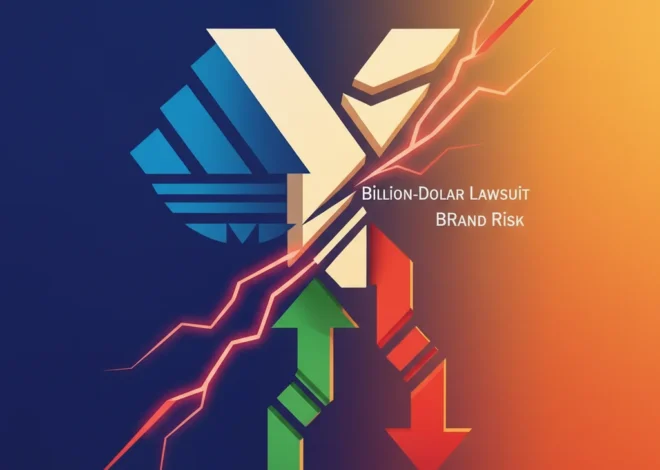
Disney’s Churn Crisis: What a Celebrity Scandal Teaches Us About AI, SaaS, and the Future of Tech
It started, as many modern corporate headaches do, with a celebrity. A late-night host, a temporary suspension, and a social media firestorm. But the real story isn’t about the controversy itself; it’s about the digital shockwave that followed. According to a startling new report, the temporary removal of Jimmy Kimmel from his show triggered a significant spike in Disney+ cancellations. The data suggests a direct correlation between the public relations flare-up and a tangible hit to the company’s bottom line.
For the casual observer, this is just another blip in the entertainment news cycle. But for developers, tech professionals, and startup founders, this incident is a critical case study—a flashing red light on the dashboard of the digital economy. It reveals the inherent volatility of subscription-based models and underscores a fundamental truth: in the age of SaaS, your greatest vulnerability isn’t always a server outage or a security breach. Sometimes, it’s a single, unpredictable event that severs the fragile connection with your user base.
This isn’t just a story about Disney. It’s a story about data, artificial intelligence, and the sophisticated software systems that are now essential for survival. Let’s peel back the layers and explore what this event truly means for the world of technology, from cloud infrastructure to the very future of programming innovation.
The Anatomy of a Digital Firestorm: Seeing the Churn in Real-Time
How did we even find out about this churn so quickly? Ten years ago, a company might not have understood the full impact of a PR crisis for weeks, until the monthly or quarterly numbers were crunched. Today, the feedback loop is instantaneous, thanks to the power of big data, cloud computing, and machine learning.
Modern streaming giants like Disney+ aren’t just content libraries; they are colossal data-processing engines. Every click, every view, every pause, and—most importantly—every cancellation is a data point fed into a massive analytics pipeline. This is where the magic of AI comes into play.
- Anomaly Detection: Sophisticated machine learning algorithms are constantly monitoring key business metrics. These systems establish a “normal” baseline for daily or even hourly cancellations. When the Kimmel news broke, these AI models would have immediately flagged the surge in cancellations as a statistical anomaly, alerting business intelligence teams in near real-time.
- Sentiment Analysis: Simultaneously, other AI tools were likely scraping public APIs from social media platforms. These Natural Language Processing (NLP) models analyze millions of posts, comments, and tweets to gauge public sentiment. They can connect the dots, identifying that the cancellation spike coincided with a surge in negative sentiment specifically mentioning “Kimmel” and “Disney+.” This capability is a game-changer for modern brand management.
- Cloud-Powered Scalability: Processing this deluge of data requires immense computational power. This is a classic use case for the cloud. Platforms like AWS, Google Cloud, or Azure provide the elastic infrastructure needed to scale up data processing jobs on demand, ensuring that insights are delivered in minutes, not days. This entire operation is a testament to the power of modern cloud-native software architecture.
This immediate, AI-driven insight allows companies to move from a reactive to a proactive stance. But understanding the problem is only the first step. The incident itself highlights a deeper challenge inherent to the entire SaaS ecosystem.
Spies, Startups, and Software: Why the UK's GCHQ is Your New Cybersecurity Partner
The SaaS Conundrum: When Your Product is Both Content and Code
At its core, Disney+ is a Software-as-a-Service (SaaS) product. Customers pay a recurring fee for access to a service. For startups and entrepreneurs in the SaaS space, the Disney-Kimmel situation is a terrifying but valuable lesson in the fragility of customer loyalty when the “service” is tied to something as subjective as entertainment or public figures.
In the SaaS world, two metrics reign supreme: Customer Lifetime Value (CLV) and Customer Acquisition Cost (CAC). A successful business model ensures that CLV is significantly higher than CAC. Sudden, unexpected churn events like this one throw a wrench into these carefully calculated models. Let’s look at a hypothetical impact analysis.
Below is a simplified table illustrating how a seemingly small percentage increase in churn can have a massive financial impact on a large-scale subscription service.
| Metric | Scenario A: Baseline | Scenario B: Post-Incident Spike |
|---|---|---|
| Subscriber Base | 150,000,000 | 150,000,000 |
| Monthly Churn Rate | 2.5% | 3.0% (a 0.5% increase) |
| Subscribers Lost Per Month | 3,750,000 | 4,500,000 |
| Monthly Recurring Revenue (MRR) Lost | $29,962,500 (at $7.99/mo) | $35,955,000 (at $7.99/mo) |
| Difference in Monthly Revenue Lost | $5,992,500 | |
| Annualized Revenue Impact | ~$72 Million | |
As the table shows, even a half-percent increase in churn, a plausible number for a major PR incident, can translate into tens of millions of dollars in lost annual revenue. This is why churn prediction and prevention are multi-billion dollar industries, driven heavily by investment in AI and automation software.
The Proactive Defense: Using Automation to Fortify Your Platform
So, how does a tech-forward company fight back? It’s not just about issuing a press release. The most effective defense is built with programming, powered by AI, and executed through automation.
A modern tech stack can be configured to respond to churn signals proactively. Imagine this automated workflow:
- Churn Prediction: A machine learning model identifies a user as “high risk” for cancellation. This prediction can be based on dozens of variables: reduced viewing time, logging in from a new device (a potential password-sharer), or even negative sentiment expressed on a linked social media account.
- Automated Intervention: Once a user is flagged, an automated system kicks in. This isn’t just a generic “Please don’t go!” email. It’s a highly personalized intervention.
- The system could analyze their viewing history and send a push notification: “Don’t miss the new episode of The Mandalorian, dropping tomorrow!”
- It could trigger a targeted in-app offer: “We see you’re thinking of leaving. Here’s a 25% discount for the next three months.”
- For high-value users, it could even escalate the issue to a human customer success agent for a personal outreach.
- Content Personalization as a Moat: The ultimate defense is making the service indispensable. This is where AI-driven recommendation engines become a core business asset. The goal of companies like Netflix and Disney is to use machine learning to know your tastes better than you do, always having the “next perfect show” queued up. A platform that consistently delivers high-value, personalized content is far “stickier” and more resilient to external shocks. This level of personalization is a key driver of innovation in the streaming wars.
From Logistics to Lending: How AI is Unlocking Africa's Trillion-Dollar SME Market
Cybersecurity’s New Frontier: When Brand Reputation is Under Attack
We typically think of cybersecurity in terms of protecting data, servers, and networks from malicious actors. However, the Disney incident forces us to broaden that definition. In the digital age, a company’s brand reputation is one of its most valuable assets, and it is constantly under a new kind of attack.
Think of a coordinated disinformation campaign or an AI-powered bot network designed to amplify negative sentiment. These are no longer hypothetical threats. They are a real and present danger that can manipulate public opinion and directly impact a company’s financial stability. This is the new frontier of cybersecurity:
- Reputational Security: Companies now need security teams that monitor for and defend against reputational attacks. This involves using AI to distinguish between genuine customer outrage and an artificial, bot-driven campaign.
- Threat Intelligence: Advanced cybersecurity software can provide threat intelligence on disinformation campaigns, helping a company prepare for a potential PR crisis before it fully erupts.
- Defensive AI: Just as attackers use AI, defenders can deploy their own machine learning models to identify and flag coordinated inauthentic behavior on social platforms, giving them a chance to report the networks and mitigate the damage.
For startups, this means that “security” can’t just be an IT-department concern. It must be integrated with marketing and communications. Protecting your brand’s digital presence is as crucial as protecting your source code.
Digital Reckoning: Why an Italian Lawsuit Could Redefine Big Tech's AI Playbook
The Innovation Imperative: Building the Anti-Fragile Platform
Ultimately, the Kimmel-Disney+ incident is a symptom of a platform that, for some users, was not indispensable. The controversy was simply the final push they needed to click “cancel.” The long-term solution, therefore, is not better PR but relentless technological innovation.
The goal for any SaaS or content platform is to become anti-fragile—a system that doesn’t just withstand shocks but potentially gets stronger from them. How is this achieved through technology?
- Deepening Engagement: Future platforms won’t just be passive content viewers. They will integrate community features, interactive content, and personalized experiences that create deep roots with the user. The more a user invests in a platform (creating playlists, joining communities, earning rewards), the higher their switching costs become.
- Diversifying Value: A platform that relies solely on one type of content or a few key personalities is inherently fragile. Innovation in programming means using data to diversify content offerings, catering to niche audiences, and creating a broad portfolio of value that can withstand the failure of any single component.
- Continuous Improvement: The software itself must be in a state of constant evolution. A/B testing, user feedback loops integrated directly into the development cycle, and AI-driven feature recommendations are all part of building a product that adapts to user needs before they even realize they have them.
Conclusion: A Lesson for Every Tech Leader
The story of a late-night host and a spike in subscription cancellations is far more than entertainment gossip. It is a powerful parable for the modern technology landscape. It teaches us that data is the lifeblood of any digital business, and artificial intelligence is the brain that makes sense of it.
It proves that the principles of SaaS—managing churn, maximizing LTV, and building a “sticky” product—apply even to the largest media conglomerates. And it reminds us that true, lasting resilience comes not from reacting to the news cycle, but from a deep, forward-thinking commitment to technological innovation, automation, and a holistic view of security that protects both code and reputation.
For every developer writing a line of code, every entrepreneur designing a subscription model, and every tech professional managing cloud infrastructure, the message is clear: the forces that shape your business can come from the most unexpected places. The best defense is to build a platform so intelligent, so personalized, and so essential that your users can’t imagine their lives without it.


